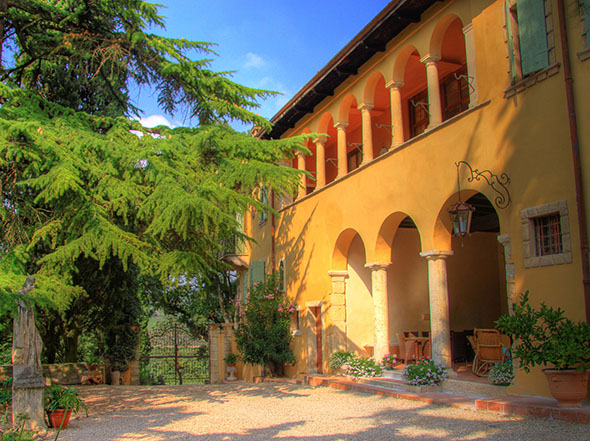
History
Prestigious
and ancient mansion situated in the pleasant and green Marcellise
valley, located just six miles from the city of Verona, the manor
“Villa Sogara” is a building the history of which has its roots deep in
the prehistoric age. In the park around the mansion many finds have
been discovered, such as spear tips, arrow tips, xysters and so on,
that are evidence of a human settlement of the paleolithic and
neolithic age similar to the one found on the top of the nearby hill of
San Briccio.
Exhaustive
studies evidenced the roman origins of the colony settled in the
Marcellise Valley (Villa Marcelli, toponym deriving
from the patronymic of a consular family). This colony derived from the
pre-existing village of San Martino Buon Albergo (2 miles far), where
still exists a roman stone monument dedicated to the Bonus
Eventus, that is the roman god of Luck.
In the
house, architectural elements likely to be of roman origin are a column
shaft, a marmoreal entablature and, probably, the two centerpiece
columns of the large lower lodge. These elements confirm the
preexistence of a building of roman age that had to be based on the
massive base stone wall, still existing in the mansion’s cellar, on
which then grew the medieval building. It can be supposed that the
various roman architectural elements, along with the masterful
perfection of the stone walls, are the remains of a small roman temple,
that was the only building in the valley dedicated to some sort of
religious cult. This fact is based also on the ancient, and nowadays
modified, topography of the valley, where all the road paths merged up
towards the location where now stands the mansion, as if it was,
indeed, a place of cult.
16th-18th
CENTURIES
Throughout
the mansion there are many remains of the medieval age, despite the
fact that the building attained its actual architectural appearance
during the 16 th - 18 th centuries. It is during these centuries that
were built the oven with owner’s bread-making right, cited in the 1769
cabreo still kept in the house, and the small bell tower, with the
peculiar bronze bell that dates back to the first part of the
seventeenth century, that was part of a gentilitial chapel now
dismantled.
From an
architectural perspective, the most important event is the renovation
of the large lower lodge that occurred in 1675. During the eighteenth
century, after 1769 (as evidenced in the south façade depicted in the
cabreo, was built the entire west wing with its elegant balcony and the
other parts of the house were completed too.
19th-20th
CENTURIES
Since the
end of the nineteenth century, the mansion suffered heavy alterations,
mainly in the Renaissance structure, to the point that both upper and
lower lodges were immured and used as stables and for other farming
purposes. The Peruzzi family, actual owner of the estate, since the
date of purchase (1929) began a drastic reversal setting up a deep and
careful restoration aimed to bring back the mansion to its original
splendour. The first works were directed and supervised by Giovan
Battista Salvi, architect, Eugenio Salvi, engineer, and Angelo Zamboni,
artist and painter. During the second world war the house was a shelter
for many families of evacuees until it was occupied and exploited, in
the years 1944-1945, as a base camp by some battalions of the german Division ‘Hermann Goering’.
After the war, the owners again undertook a long series of restorations
that brought the mansion to its actual conditions.
MOST
DISTINGUISHED GUESTS
In the
nineteenth century, during the napoleonic campaign of Italy, the
mansion hosted His Imperial Highness the Viceroy of Italy Prince
Eugène de Beauharnais, that left a precious and exquisite
souvenir gift that is still preserved in the house. Under the Imperial
government of the Kingdom of Lombardy-Venetia, the
mansion was residence of the last Hapsburgic mayor of Verona, Edoardo
De Betta, member of the Academy
of Agriculture Science and
Literature of Verona, eminent scientist and humanist, author
of various scientific works. As the mayor of Verona, Edoardo De Betta
received at Villa Sogara the official visit of Their Imperial and Royal
Majesties The Emperor Franz Joseph I and The Empress Elisabeth of Austria-Hungary.